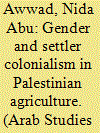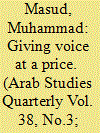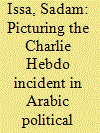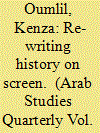| Srl | Item |
| 1 |
ID:
147387


|
|
|
|
|
| Summary/Abstract |
The gendered nature of the agricultural sector is significantly influenced by the political and socio-economic and cultural structure of any society. The division of labor between males and females within the family farm is seriously affected as a response to economic pressures along with the impact of other restrictions imposed by predetermined gender roles. In the Palestinian context, economic pressures were created mainly by the structural transformation in Palestinian agriculture following the Zionist settler colonization of Palestine, along with other minor factors related to the Palestinian neoliberal economic policies dictated by the international financial institution and Zionist interests. This article argues that the gendered nature of the Palestinian agriculture sector has been transformed and has promoted women's exploitation as follows: First, restructure of the agricultural employment by the decline of both women's and men's employment of the total Palestinian labor force within serious exploitive and fluctuating conditions; second, changes in tasks and division of labor, women's property rights for agricultural land resources and services provided by the Palestinian Authority; and finally increasing women's burden by increasing their time allocation for agricultural tasks. The data presented in the article are based on a comprehensive analysis of secondary information on Palestinian agriculture, and primary data collected in 2010 with the help of a few households case studies (life history) from two locations in the central region of the West Bank.
|
|
|
|
|
|
|
|
|
|
|
|
|
|
|
|
| 2 |
ID:
147390


|
|
|
|
|
| Summary/Abstract |
This article examines two of Elizabeth Laird's young adult novels that are set in the Arab world: A Little Piece of Ground and Oranges in No Man's Land. It shows that despite occasionally relying on some of the stereotypical themes and subjects in books about the Arab world, Laird's novels manage to interrogate relevant and pressing issues about the region, including the question of Palestine. The article further surveys a number of children's and young adult books about the Arab world that are written by western authors. It explores how these texts rely on stereotypical constructions that cast the region as a place of ultimate violence, poverty, religious oppression, and patriarchal tyranny. The article concludes with highlighting the urgency to disrupt these generalizations, diversify thematic foci, and present readers with heterogeneous Arab characters and settings.
|
|
|
|
|
|
|
|
|
|
|
|
|
|
|
|
| 3 |
ID:
147388


|
|
|
|
|
| Summary/Abstract |
This article investigates how the Arabic political cartoons picture the mocking cartoons of the Prophet Muhammad by the French satirical Charlie Hebdo magazine.1 It is noticed that the cartoons utilize the Charlie Hebdo incident as a locus to deconstruct the unjustness and bias of the Arabic leadership and the international community in their dealing with some Arabic political issues. The surveyed cartoons also used the Charlie Hebdo incident as a locus to formulate the Palestinian “imagined community” (Anderson, 1991). I argue that the surveyed cartoons use the strategy of “differentiation” (Meyer, 2000) based on the self vs. other dichotomy to establish this deconstruction and imagined community. The study uses the semio-linguistic and visual rhetorical tools (Barthes, 1972), and self-categorization (Turner, 1987) to achieve this deconstruction, through an analysis of semiotic-discursive aspects of a small corpus of Arabic political cartoons. The findings indicate that promoting a discourse of fear and danger toward the inside and outside actors is what constitutes this self-other-based identity.
|
|
|
|
|
|
|
|
|
|
|
|
|
|
|
|
| 4 |
ID:
147389


|
|
|
|
|
| Summary/Abstract |
This article examines how the award winning film Salt of This Sea (2008) responds to dominant gendered representations of Arab and Palestinian identity. The choice of this film is based on its significance as a contemporary cinematic text that aims to present alternative portrayals to those prevalent in the media. Furthermore, Annemarie Jacir is the first Palestinian female filmmaker to make a full-length feature film. The film puts a courageous female character (Soraya—played by Suheir Hammad) at the center of its narrative. It refreshingly departs from inflicting a male gaze on the lead female actor. Salt of This Sea responds to the dominant construction of Arab and Muslim women as passive with the portrayal of a determined heroine. In regard to portrayals of masculinity, the film attempts to challenge the core stereotype of Palestinian men as violent. Overall, the film is part of a movement to re-write a collective history, but it depicts dimensions of Palestinian history that are seldom shown in the mainstream media.
|
|
|
|
|
|
|
|
|
|
|
|
|
|
|
|